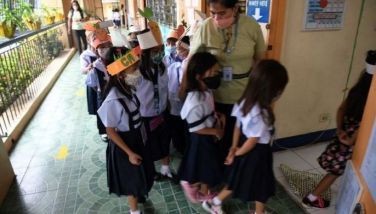100 years of Pinoy presence in US commemorated
May 21, 2006 | 12:00am
 WASHINGTON, DC — Made in the Philippines, naturalized in the US.
WASHINGTON, DC — Made in the Philippines, naturalized in the US.
As the US Congress pondered the fate of 12 million illegal immigrants and debated how to stop more of them from entering the country, the Filipino-American community came out in full force to attend a gala reception at the Smithsonian Institution commemorating 100 years of Filipino immigration to the United States.
"Thank you for your contributions to your adopted country. I look forward to the day when a Filipino-American is elected to the US Congress and goes there in his Barong Tagalog," Democratic congressman Ed Case of Hawaii, one of the strongest supporters of the community, told the audience.
Case has filed a bill in the House providing for the speedy reunification of the families of naturalized Filipino World War II veterans, many of whom have been waiting from 10 to 20 years for US visas to be issued to their adult children in the Philippines.
Other invitees at the reception on Wednesday included Congressman Mike Honda of California, Loida Nicolas Lewis, head of the National Federation of Filipino American Associations (NaFFAA), and Vellie Dietrich Hall of the White House Commission for Asian and Pacific Islander Affairs.
From a handful of Filipinos who first arrived to work in the sugarcane fields of Hawaii the community has grown to some 2.5 million many of them professionals spread throughout the length and breadth of the nation.
There are about eight million Filipinos overseas. Last year, they remitted about $11 billion to the Philippines, with 60 percent of the total coming from Filipinos in North America.
Lewis said she was working to harness Filipino power worldwide so they can play a role in the unfolding events in the Philippines. They should have an input in the proposed Charter change, she stressed.
The Washington reception attended by about 250 people is the first in a series of celebrations in various parts of the country to provide a historical overview of Filipino Americans in the United States — their struggles, contributions, challenges and achievements.
As guests meandered about the reception area looking at rare photographs of early Filipino immigrants, a block away several hundred mostly Latino immigrants demonstrated against the passage of a House bill which makes it a felony to be in the United States illegally and imposes new penalties on employers who hire illegal immigrants.
It is estimated there are between 200,000 and 300,000 illegal Filipino immigrants.
The photo exhibit sponsored by the Smithsonian Asian Pacific American Program (APA) will be on display in Washington until Aug. 20 after which they will be shown in other states.
The display features rare photographs and illustrations from the National Archives, the Library of Congress and personal collections traces the beginnings of Filipino presence in the United States.
Similar events including performances, film shows and panel discussions will be held in cities with major Filipino American populations including San Francisco, Los Angeles, Las Vegas, Chicago and New York throughout the year to mark the centennial.
BrandSpace Articles
<
>
- Latest
Latest
Latest
December 14, 2024 - 11:22am
By Karry Sison | December 14, 2024 - 11:22am
December 9, 2024 - 2:53pm
By Rupert Paul Manhit | December 9, 2024 - 2:53pm
December 8, 2024 - 9:00am
By Jing Castañeda | December 8, 2024 - 9:00am
November 30, 2024 - 5:19pm
By Joanna Perfecto | November 30, 2024 - 5:19pm
November 23, 2024 - 6:23pm
By Rupert Paul Manhit | November 23, 2024 - 6:23pm
November 23, 2024 - 1:52pm
By Edilberto de Jesus | November 23, 2024 - 1:52pm
Recommended





























